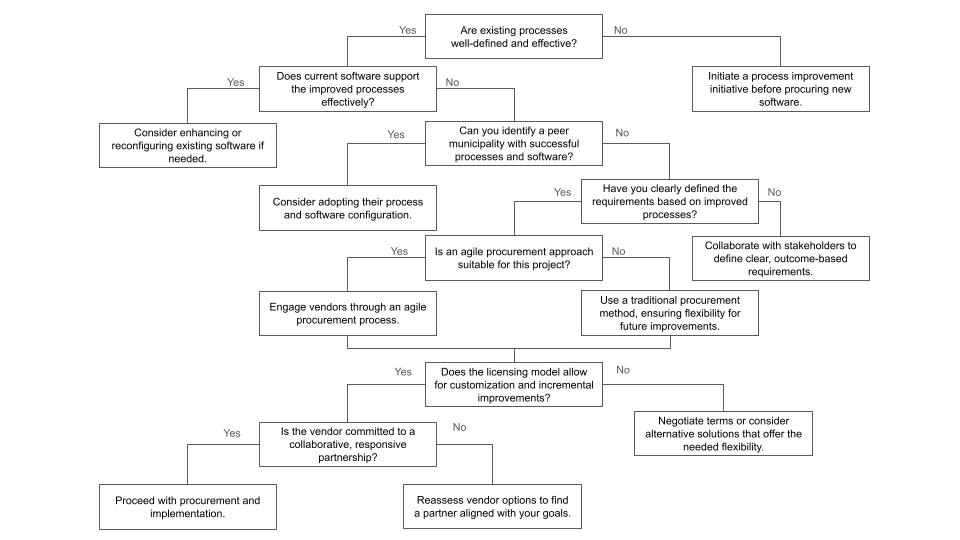Software Procurement
- Authors
In this Chapter, we outline core principles for successful software procurement in municipal governments, emphasizing that mature, well‑defined processes must precede any technology selection
When processes are sound, enhancing or reconfiguring existing software, rather than wholesale replacement, minimizes risk and disruption Public Sector Procurement Fit for the Digital Age. Conversely, if processes are weak, cities should first adopt best‑in‑class workflows from peer organizations before procuring new systems. Embracing agile, incremental procurement models fosters closer vendor collaboration, adaptability to evolving requirements, and faster delivery of value GAO Agile Assessment Guide. Finally, a clear grasp of software licensing (proprietary, open source, and shared source) and ownership rights empowers cities to negotiate favorable terms, maintain flexibility, and establish lasting partnerships.
A Guide to Successful Municipal Software Procurement
Introduction
Effective software procurement is a powerful tool for municipalities aiming to enhance their operations and better serve their communities. By aligning technology acquisitions with well-defined processes and fostering collaborative vendor relationships, cities can achieve sustainable improvements and deliver greater value to their constituents.
1. Prioritize Process Excellence Before Software Selection
1.1 Establish Clear and Effective Processes
Before considering new software solutions, it's essential to ensure that existing processes are efficient and well-documented. A thorough evaluation of current workflows helps identify areas for improvement and ensures that technology investments are aligned with organizational needs.
1.2 Enhance Existing Systems When Possible
If current software systems support effective processes but lack certain functionalities, consider upgrading or reconfiguring these systems. This approach can be more cost-effective and less disruptive than a complete replacement, provided that licensing agreements permit such enhancements.
2. Adopt Proven Practices for Process Improvement
2.1 Learn from Peer Successes
Municipalities can benefit from adopting best practices implemented by peer organizations. By studying successful case studies and adapting proven workflows, cities can accelerate process improvements and reduce the risks associated with untested methods.
2.2 Collaborate with Responsive Vendors
Engaging with vendors who are committed to continuous improvement and responsive support is crucial. Establishing partnerships that allow for incremental enhancements ensures that software solutions evolve alongside organizational needs.
3. Embrace Agile Procurement Methodologies
3.1 Understand Agile Procurement
Agile procurement involves iterative development, frequent stakeholder engagement, and flexibility to adapt to changing requirements. This approach contrasts with traditional procurement methods by focusing on delivering value early and continuously refining solutions.
3.2 Implement Agile Best Practices
- Early and Ongoing Vendor Engagement: Maintain open communication with vendors to align on goals and address challenges promptly.
- Iterative Delivery: Break down projects into manageable phases, allowing for regular feedback and adjustments.
- Flexible Contracting: Develop contracts that accommodate changes and encourage innovation, reducing the need for extensive renegotiations.
4.1 Demystify Licensing Models
Understanding different licensing models is key to making informed procurement decisions:
- Proprietary Software: Licensed under restrictive terms, offering vendor support but limited customization.
- Open Source Software: Provides access to source code, allowing for modifications and community collaboration.
- Shared Source Software: A hybrid model offering some access to source code under specific conditions.
4.2 Align Licensing with Organizational Goals
Select licensing models that align with your municipality's capacity for support, customization needs, and long-term strategic objectives. This alignment ensures that software solutions remain effective and adaptable over time.
5. Foster Strong Vendor Partnerships
5.1 Select Vendors with a Collaborative Mindset
Choose vendors who demonstrate a commitment to partnership, transparency, and shared success. Look for those with a track record of responsive support and a willingness to engage in continuous improvement initiatives.
5.2 Establish Effective Governance Structures
Implement governance frameworks that facilitate regular performance reviews, shared key performance indicators (KPIs), and clear communication channels. These structures help maintain alignment between the municipality and the vendor, ensuring that projects stay on track and objectives are met.
6. Shorten Time to Deployment
| Stage | Description | Estimated Duration |
|---|---|---|
| Process Assessment & Improvement | Evaluate and refine existing workflows to ensure readiness for new software. | 2–4 weeks |
| Requirements Definition | Collaborate with stakeholders to define clear, outcome-based requirements. | 2–3 weeks |
| Market Research & Vendor Shortlisting | Identify potential vendors and solutions that meet defined requirements. | 2–3 weeks |
| Solicitation Preparation | Develop and issue RFPs/RFQs, including necessary documentation. | 2–4 weeks |
| Solicitation Process | Allow vendors to prepare and submit proposals; address any queries. | 3–6 weeks |
| Evaluation & Selection | Review proposals, conduct evaluations, and select the best-fit vendor. | 3–4 weeks |
| Contract Negotiation & Award | Negotiate terms and finalize the contract with the selected vendor. | 2–3 weeks |
| Implementation Planning | Develop a detailed plan for software deployment and integration. | 2–3 weeks |
| Software Deployment & Training | Install the software, migrate data, and train end-users. | 4–8 weeks |
| Post-Implementation Review | Assess the software's performance and gather feedback for improvements. | 2–3 weeks |
The estimated timeline for municipal software procurement intentionally omits a lengthy pre-deployment software development phase. This approach aligns with best practices that prioritize deploying existing configurations and customizing post-deployment through agile methodologies. Here's why this strategy is advantageous:
🚫 Challenges of Extensive Pre-Deployment Customization
Increased Risk of Delays and Budget Overruns Extensive customization before deployment can lead to feature creep, where the addition of new features extends beyond the original scope. This often results in project delays and budget overruns.
Technical Debt and Maintenance Complexity Highly customized software accumulates technical debt, making future updates and maintenance more complex and costly. This complexity can hinder the software's adaptability to evolving needs.
Delayed User Feedback Integration Customizing extensively before users interact with the software delays the collection of real-world feedback, which is crucial for ensuring the software meets actual user needs.
✅ Advantages of Deploying Existing Configurations with Agile Post-Deployment Customization
Accelerated Time-to-Value Deploying existing configurations allows municipalities to start realizing benefits sooner. Immediate deployment enables users to begin using the software, facilitating quicker returns on investment.
Iterative Improvements Based on Real User Feedback Post-deployment customization within an agile framework allows for iterative enhancements based on actual user experiences and feedback, leading to more user-centric solutions.
Reduced Risk Through Incremental Changes Making smaller, incremental changes post-deployment reduces the risk of significant disruptions and makes it easier to identify and address issues promptly.
Enhanced Flexibility and Adaptability An agile approach to post-deployment customization provides the flexibility to adapt to changing requirements and priorities, ensuring the software remains aligned with organizational goals.
🔄 Recommended Approach
Deploy Standard Configurations Initially: Begin with the software configured to best in class city configuration to minimize initial complexity.
Engage Users Early: Allow users to interact with the software learning best in class city processes early on to gather valuable feedback.
Implement Agile Customizations: Use agile methodologies to make iterative improvements based on user feedback and evolving needs.
Monitor and Adjust: Continuously monitor the software's performance and make necessary adjustments to optimize functionality and user satisfaction.
By adopting this approach, municipalities can enhance the efficiency and effectiveness of their software procurement and implementation processes, leading to better outcomes and more sustainable solutions.
Conclusion and Practitioner’s Checklist
By focusing on process excellence, adopting agile procurement methods, understanding licensing implications, and building collaborative vendor relationships, municipalities can transform software procurement into a strategic advantage.
Checklist for Successful Software Procurement
- Process Evaluation: Assess and document current workflows to identify improvement opportunities.
- Peer Benchmarking: Research and adopt best practices from similar municipalities.
- Vendor Collaboration: Engage vendors early and establish open lines of communication.
- Agile Implementation: Apply agile principles to manage procurement projects effectively.
- Licensing Strategy: Choose licensing models that support your municipality's goals and capabilities.
- Governance Framework: Set up structures to monitor progress, manage risks, and ensure accountability.
By adhering to these guidelines, cities can navigate the complexities of software procurement with confidence, leading to enhanced services and better outcomes for their communities.


